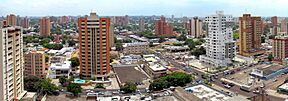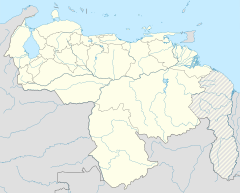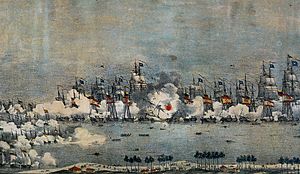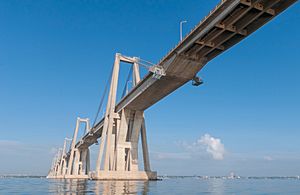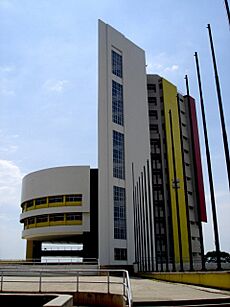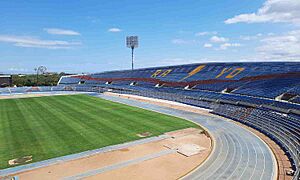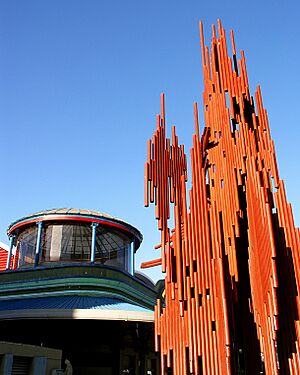Maracaibo facts for kids
Quick facts for kids
Maracaibo
|
|||
|---|---|---|---|
|
Municipality
|
|||
|
(From top, left to right) Panorama of downtown area; Maracaibo Cathedral; Lake Maracaibo and Rafael Urdaneta Bridge; Urdaneta Museum; Carabobo Street
|
|||
|
|||
| Nickname(s):
"La Tierra del Sol Amada"
(English: "The Beloved Land of the Sun") |
|||
| Motto(s):
"Muy noble y leal"
(English: "Very noble and loyal") |
|||
| Country | |||
| State | |||
| Founded | (1) 8 September 1529, (2) 1569, (3) 1574 | ||
| Founded by | Ambrosio Alfínger (1529), Captain Alonso Pacheco (1569), Captain Pedro Maldonado (1574) | ||
| Government | |||
| • Type | Mayor–council | ||
| • Body | Alcaldía de Maracaibo | ||
| Area | |||
| • Metro | 1,393 km2 (538 sq mi) | ||
| Elevation | 6 m (20 ft) | ||
| Population
(2020)
|
|||
| • Municipality | 2,658,355 | ||
| • Rank | 2nd | ||
| • Metro | 5,278,448 | ||
| Demonym(s) | Marabin, Maracaibero(a), Maracucho(a) | ||
| Time zone | UTC−4 (VET) | ||
| Postal coded |
4001, 4002, 4003, 4004, 4005
|
||
| Area code | 261 | ||
| ISO 3166 code | VE-V | ||
| Climate | BSh | ||
| The area and population figures refer to the municipality of Maracaibo. | |||
Maracaibo is a large city and municipality in northwestern Venezuela. It is located on the western shore of the strait that connects Lake Maracaibo to the Gulf of Venezuela. Maracaibo is the second-largest city in Venezuela, after the capital city, Caracas. It is also the capital of the state of Zulia.
The city's population is about 2.6 million people. Its larger metropolitan area has an estimated 5.2 million people as of 2010. Maracaibo is often called "The Beloved Land of the Sun" (Spanish: La Tierra del Sol Amada).
Maracaibo is a very important economic hub for western Venezuela. This is mainly because of the oil industry that grew around Lake Maracaibo. It is sometimes known as "The First City of Venezuela." This is because it was the first city in Venezuela to have public services like electricity. The name Venezuela is also thought to have come from the Lake Maracaibo area.
The first people to live here were Arawak and Carib tribes. Maracaibo was founded three times because early attempts failed. The first try was in 1529 by Captain Ambrosio Ehinger. Another attempt was made in 1569 by Captain Alonso Pacheco. The city was finally founded in 1574 by Captain Pedro Maldonado. It was named Nueva Zamora de la Laguna de Maracaibo.
Later, in 1917, oil was discovered in the area. This led to a huge increase in the city's population as many people moved there for work. Today, La Chinita International Airport serves Maracaibo. The General Rafael Urdaneta Bridge connects Maracaibo to the rest of Venezuela.
Contents
What's in a Name?
The name Maracaibo is believed to come from a brave indigenous chief named Mara. He was a young leader who fought bravely against the Spanish. Legend says that when Mara fell in battle, his people, the Coquivacoa, shouted "Mara cayó!" which means "Mara fell!" This story is said to be the origin of the city's name.
However, some historians think the name comes from the local language. They say "Maara-iwo" meant "Place where serpents abound."
City History
The first people living in this area were the Arawak and Carib tribes. The Añu tribe, a smaller group, built many stilt houses along the northern shore of Lake Maracaibo. Europeans first arrived in 1499.
How Maracaibo Was Founded
The city was founded three times. The first attempt was in 1529 by a German explorer named Ambrosius Ehinger. He named the settlement New Nuremberg. However, the lack of activity led to the village being moved in 1535.
Captain Alonso Pacheco made a second attempt to found the city in 1569. But the settlement had to be left in 1573 due to strong attacks from local tribes.
The European settlement returned shortly after. In 1574, Captain Pedro Maldonado officially re-founded the city. He named it Nueva Zamora de Maracaibo. "Nueva Zamora" came from the Spanish city where Governor Diego de Mazariegos was born. From this time, the city began to grow. It was built on the western side of Lake Maracaibo, which is rich in oil. The city's location, with good winds and a safe harbor, helped it develop.
Pirate Attacks
Maracaibo faced many attacks from pirates. In 1614, a Dutch pirate named Henrik de Gerard robbed the city. In 1642, the British pirate William Jackson attacked.
In 1667, a pirate named l'Olonnais and his crew attacked Maracaibo and another town called Gibraltar. They stole a Spanish treasure ship filled with valuable goods.
In March 1669, Henry Morgan also attacked Maracaibo. The city was empty when his ships arrived. He then moved on to Gibraltar to find more treasure. When Morgan tried to leave the lake, a Spanish fort and three Spanish ships blocked his way. He used a clever trick with a dummy ship full of gunpowder to destroy two of the Spanish ships. He then tricked the Spanish governor at the fort to move his cannons. This allowed Morgan to escape.
In 1678, a French commander named Michel de Grammont captured Maracaibo. He then robbed several smaller towns, going as far inland as Trujillo.
Venezuela's Fight for Freedom
In 1810, the province of Maracaibo chose to stay loyal to the Spanish crown. It did not join the First Republic of Venezuela in its fight for independence.
By 1821, people in favor of independence started fighting. The royalists, who supported Spain, fought against the patriots, who wanted independence. The patriots were led by Rafael Urdaneta. The royalists took back control in 1822. However, they were defeated in the Battle of Lake Maracaibo on July 24, 1823. This battle was the final step in Venezuela's fight for independence.
A Time of Being Apart
For about 380 years, Maracaibo was quite separate from the rest of Venezuela. People traveled to and from the city by boats and ferries across the lake. Trade and culture flowed between Maracaibo and the Caribbean Sea. This included places like the Dutch Antilles, Colombian cities, Cuba, and later Miami and New York.
Being isolated was both a challenge and a benefit. It made the people of Maracaibo very independent thinkers. There are many stories about the idea of an independent nation called "The Independent Republic of Zulia." However, this never happened.
In the 1900s, cars and trucks became common. Goods were moved by ferry between Maracaibo and the eastern shore of the lake. The economy of Maracaibo was more connected to Colombia and the Caribbean than to eastern Venezuela. This was because of the easy water route through Lake Maracaibo to the sea.
In 1903, during a naval blockade of Venezuela, a German warship tried to enter Lake Maracaibo. It exchanged fire with Fort San Carlos but had to pull back. Later, a stronger German ship bombarded the fort, destroying it.
Building the Bridge
In the 1950s, the government decided to build a bridge connecting the two sides of Lake Maracaibo. This was to better connect Maracaibo to the rest of the country.
Many designs were considered, some even including train tracks. But after the government changed in 1958, a simpler design was chosen. The bridge was named El Puente sobre el Lago de Maracaibo "General Rafael Urdaneta". It was named after Rafael Urdaneta, a hero of the war for independence.
The bridge opened in 1962. It connected the city to the opposite shore and the country's highway system. Building this bridge was a huge achievement. It was the longest prestressed concrete bridge in the world when it was finished. Today, it remains a vital link for Maracaibo and the state of Zulia.
Maracaibo Today
Maracaibo has grown into a large metropolitan city. It includes two main areas: Maracaibo itself and the municipality of San Francisco. In recent years, many people have moved to Maracaibo from rural areas and other cities.
Maracaibo is home to some excellent universities. The state university, La Universidad del Zulia (LUZ), is well-known for its law, medical, and engineering programs. Other universities include Universidad Dr. Rafael Belloso Chacín (URBE) and Universidad Rafael Urdaneta.
In 2019, the city faced challenges like power outages and poverty. This led to some violence and looting. Many people moved away, especially to the United States.
Economy
The main sources of income for Zulia state, where Maracaibo is located, are:
- Oil extraction and refining.
- Agriculture, including coffee, rice, corn, cassava, cocoa, and sugar cane.
- Livestock production.
- Mining, such as clay, limestone, coal, and sand.
Geography
The municipality of Maracaibo is divided into 18 parishes:
|
Districts
- Venancio Pulgar
- Idelfonso Vázquez
- Coquivacoa
- Barrio 18 de Octubre
- Juana de Ávila
- El Naranjal
- San Jacinto (La Marina)
- Mara Norte
- La Trinidad
- Las Tarabas
- La Estrella
- Maracaibo I
- Maracaibo II
- Lago Mar Beach
- Antonio Borjas Romero
- San Isidro
- Francisco Eugenio Bustamante
- San Rafael
- Ziruma
- San Miguel
- Luis Hurtado Higuera
- Manuel Dagnino
- Cristo de Aranza
- Cecilio Acosta
- Cacique Mara
- El Amparo
- Raúl Leoni
- Caracciolo Parra Pérez
- Los Olivos
- Chiquinquirá
- Santa Lucía
- Santa Rosa
- Bolívar
- Bella Vista
- Historic zone of Maracaibo
- El Saladillo
- Isla Dorada
Climate
Maracaibo is one of the hottest cities in Venezuela and all of South America. The Sierra Nevada de Santa Marta mountains block rain, giving the city a hot semi-arid climate. This means it's hot and dry, but the nearby lake helps to cool it down a bit.
The average temperature in Maracaibo is about 29°C (84°F). In the past, the mix of high temperatures and humidity made the climate unhealthy. But today, with better city development and pest control, these health issues are mostly gone. The highest temperature ever recorded was 43.6°C (110.5°F), and the lowest was 18.8°C (65.8°F).
| Climate data for Maracaibo (1991–2020, extremes 1961–2020) | |||||||||||||
|---|---|---|---|---|---|---|---|---|---|---|---|---|---|
| Month | Jan | Feb | Mar | Apr | May | Jun | Jul | Aug | Sep | Oct | Nov | Dec | Year |
| Record high °C (°F) | 36.7 (98.1) |
39.4 (102.9) |
39.0 (102.2) |
40.0 (104.0) |
39.8 (103.6) |
39.6 (103.3) |
39.4 (102.9) |
42.2 (108.0) |
39.0 (102.2) |
39.9 (103.8) |
37.0 (98.6) |
39.5 (103.1) |
42.2 (108.0) |
| Mean daily maximum °C (°F) | 33.1 (91.6) |
33.3 (91.9) |
33.7 (92.7) |
34.0 (93.2) |
34.2 (93.6) |
34.5 (94.1) |
34.8 (94.6) |
35.1 (95.2) |
34.2 (93.6) |
33.1 (91.6) |
32.7 (90.9) |
32.9 (91.2) |
33.8 (92.8) |
| Daily mean °C (°F) | 27.0 (80.6) |
27.3 (81.1) |
27.9 (82.2) |
28.7 (83.7) |
28.7 (83.7) |
29.4 (84.9) |
29.4 (84.9) |
29.8 (85.6) |
28.9 (84.0) |
27.9 (82.2) |
27.0 (80.6) |
27.3 (81.1) |
28.3 (82.9) |
| Mean daily minimum °C (°F) | 23.1 (73.6) |
23.4 (74.1) |
24.1 (75.4) |
25.2 (77.4) |
25.7 (78.3) |
25.7 (78.3) |
25.6 (78.1) |
25.9 (78.6) |
25.5 (77.9) |
24.9 (76.8) |
24.6 (76.3) |
23.8 (74.8) |
24.8 (76.6) |
| Record low °C (°F) | 19.2 (66.6) |
18.8 (65.8) |
20.3 (68.5) |
20.7 (69.3) |
20.5 (68.9) |
20.2 (68.4) |
21.0 (69.8) |
20.2 (68.4) |
20.2 (68.4) |
19.8 (67.6) |
20.1 (68.2) |
18.9 (66.0) |
18.8 (65.8) |
| Average rainfall mm (inches) | 5.8 (0.23) |
3.6 (0.14) |
11.4 (0.45) |
41.1 (1.62) |
85.5 (3.37) |
48.6 (1.91) |
31.3 (1.23) |
70.1 (2.76) |
114.9 (4.52) |
122.9 (4.84) |
82.3 (3.24) |
31.8 (1.25) |
649.3 (25.56) |
| Average rainy days (≥ 1.0 mm) | 1.1 | 1.0 | 1.5 | 4.4 | 7.2 | 5.4 | 4.1 | 6.8 | 10.5 | 11.1 | 7.0 | 2.9 | 63.0 |
| Average relative humidity (%) | 69.0 | 68.5 | 68.0 | 71.5 | 73.5 | 71.0 | 69.0 | 69.5 | 72.0 | 75.0 | 73.0 | 72.0 | 71.0 |
| Mean monthly sunshine hours | 266.6 | 240.8 | 244.9 | 183.0 | 179.8 | 201.0 | 244.9 | 232.5 | 192.0 | 182.9 | 204.0 | 238.7 | 2,611.1 |
| Mean daily sunshine hours | 8.6 | 8.6 | 7.9 | 6.1 | 5.8 | 6.7 | 7.9 | 7.5 | 6.4 | 5.9 | 6.8 | 7.7 | 7.2 |
| Source 1: NOAA (sun 1961–1990) | |||||||||||||
| Source 2: Instituto Nacional de Meteorología e Hidrología (humidity 1970–1998) | |||||||||||||
Education
Maracaibo has several universities and schools:
Colleges and Universities
- Universidad del Zulia - (LUZ)
- Nacional Experimental de la Fuerza Armada UNEFA
- Universidad Rafael Belloso Chacín - (URBE)
- Universidad Rafael Urdaneta
- Universidad Católica Cecilio Acosta
- Universidad Dr. José Gregorio Hernández
- Universidad Bolivariano de Venezuela sede Zulia
- Universidad Nacional Abierta (UNA) Centro Local Zulia
International Schools
- Escuela Bella Vista (American school)
- Colegio Alemán de Maracaibo, formerly Colegio Alemán del Zulia (German school)
Sports
People from Maracaibo are very proud of their local sports teams.
- In baseball, the city is home to the Águilas del Zulia. This team plays in the Venezuelan winter league. Their home stadium is the Estadio Luis Aparicio El Grande.
- The city's basketball team is Gaiteros del Zulia. They play in the Liga Profesional de Baloncesto de Venezuela. Their home stadium is the Pedro Elías Belisario Aponte stadium.
- In football, Maracaibo has the Unión Atlético Maracaibo and the Zulia FC.
- For Rugby, there are the Maracaibo Rugby Football Club and the Zulianos Rugby Club. Rugby was first played in Maracaibo in Venezuela. This was thanks to the English community living in the Zulia State.
Maracaibo teams have also done well in youth sports. In the 2000 Little League World Series, the Sierra Maestra Little League team from Maracaibo won the championship. The Coquivocoa Little League team from Maracaibo placed third in the 1974 Little League World Series.
Culture
Maracaibo's culture has strong influences from its indigenous roots. This can be seen in its music, desserts, and customs. The culture in Maracaibo is quite different from that in Caracas. For example, in Caracas, Coke is the most popular soft drink, but in Maracaibo, it's Pepsi. This difference means many brands create special local ads for their products.
The Gaita is a type of Venezuelan folk music that comes from Maracaibo. The name might come from the Gothic word for "goat," because goat skin is often used for the "furro" instrument. Other instruments used in gaita include maracas, cuatro, charrasca, and tambora (a Venezuelan drum). Gaita songs can be funny, about love, or even protest songs. This music became popular across Venezuela in the 1960s. In the 1970s, it started to mix with other styles like salsa and merengue. Famous gaita groups include Maracaibo 15, Gran Coquivacoa, and Cardenales del Éxito.
Museums, Cultural Centers, and Theaters
- Zulia Contemporary Art Museum (MACZUL)
- General Rafael Urdaneta Museum
- "Balmiro León" Municipal Graphic Arts Museum
- Maracaibo's Fine Arts Centre
- Maracaibo's "Lía Bermúdez" Art Centre
- Baralt Theatre
- Museum of Gaita
Libraries
- Public Library of Zulia
- "Arturo Uslar Pietri" Public Library
- "Dr. Pedro Alciro Barboza de la Torre" Library
- "Simón Palmar" Public Library
- Biblioteca Pública "Luís Guillermo Pineda Belloso" (Public, bilingual, and circulating)
- "Pedagógica" Specialized Public Library
- "SEDINI" Specialized Public Library
- "Dr. Nectario Andrade Labarca" Private Library
Notable People
- Wilyer Abreu - baseball player
- Teolindo Acosta - baseball player
- José Andrés Martínez - professional MLS soccer player
- Gustavo Aguado - musician, singer and leader of Guaco music band
- Ricardo Aguirre - composer and singer
- Daniel Alvarado - singer and actor
- Wilson Álvarez - Major League Baseball left-handed pitcher
- Ernesto Aparicio - former shortstop in Venezuelan League Baseball
- Luis Aparicio - shortstop, Major League Baseball Hall of Fame
- Rafael Maria Baralt - diplomat, writer, philologist, historian
- Jessica Barboza Schmidt - model and beauty pageant
- Omar Barboza- politician
- Huascar Barradas - flutist
- Lionel Belasco - pianist, composer and bandleader, known for calypso recordings
- Marisela Berti - actress, singer, show host and beauty queen
- José Bracho - baseball pitcher
- Silvino Bracho - baseball pitcher
- Antonio Briñez - first manager to win a National Amateur Baseball championship to Venezuela
- María Calcaño - poet
- José Antonio Casanova - baseball player and team manager
- Abel Castellano Jr. - jockey
- Javier Castellano - jockey Eclipse Award 2013, 2014, 2015, 2016. Hall of Fame
- Leopoldo Castillo - journalist. TV host
- Gustavo Chacín - baseball player
- Jackson Chourio - baseball player
- Fernando Chumaceiro - Lawyer and politician
- Johana Clavel - cook and entrepreneur
- Luis Contreras - baseball player
- Gilberto Correa - TV host
- David Cubillan - basketball player
- Chiquinquirá Delgado - actress and TV host
- Elías Díaz - MLB baseball player
- Xabier Elorriaga- actor
- Heraclio Fernández - pianist and composer
- Lupita Ferrer - actress
- Juan Fuenmayor - soccer player
- Manuel Gogorza- military
- Betulio González - boxer
- Carlos González - baseball player
- Geremi González - Major League Baseball player for several teams
- Inés González Árraga - chemist and former political prisoner
- Mariana González Parra - fencer
- Ulises Hadjis- singer-songwriter and multi instrumentalist
- Alejandro Hernández - Internet comedian
- Jonathan Herrera - baseball player
- Wilmer Herrison - painter
- Ender Inciarte - MLB baseball player
- Daniela Larreal - cyclist sprinter
- Ninibeth Leal - Miss Venezuela World 1991, Miss World 1991
- Tulio Enrique León - blind organist, composer, and arranger
- Sandy León - MLB baseball player
- Carlos López Bustamante - journalist, known for his opposition to Juan Vicente Gómez
- Eduardo López Bustamante - journalist, lawyer, and poet
- Teresa López Bustamante - journalist, founder of the Catholic Venezuelan newspaper
- Eduardo López Rivas - editor and journalist
- Roberto Lückert León - Roman Catholic prelate
- Betty Cecilia Lugo - Philanthropist
- Julio Machado - Major League Baseball pitcher
- Carlos Ramírez MacGregor - journalist, politician and writer
- Domingo Marcucci - shipbuilder and shipowner in San Francisco, California
- Ernesto Mayz Vallenilla - philosopher, rector of Simón Bolívar University (Venezuela)
- Armando Molero - songwriter
- Carlos Molina Tamayo - navy militar
- Ricardo Montaner - Venezuelan musician
- Carmen Maria Montiel - Miss Venezuela 1984, Miss Universe 1984 2nd runner-up
- Carlos Caridad-Montero - film producer
- Humberto Fernández Morán - research scientist, founded the Venezuelan scientific research institute
- Lila Morillo - actress and singer
- Francisco Ochoa - first President of the Universidad del Zulia
- Rougned Odor - MLB baseball player
- Gastón Parra Luzardo- Economist president of PDVSA in 2002
- Gerardo Parra- MLB baseball player
- Nestor Perez Luzardo- lawyer and singer
- Felipe Pirela- singer
- Nick Pocock - former cricketer, ex-captain of Hampshire County Cricket Club
- Oswaldo Álvarez Paz - First elected Governor
- L. Rafael Reif - electrical engineer and the 17th President of the Massachusetts Institute of Technology
- Graciela Rincón Calcaño - poet
- Rafael Romero Sandrea - track and field athlete
- Daniel Sarcos - Telemundo TV host
- Jefferson Savarino - footballer
- Monica Spear - Miss Venezuela 2004, Miss Universe 2005 4th runner-up, actress
- Orlando Urdaneta - actor
- Rafael Urdaneta - hero of the Latin American war for independence
- Vivian Urdaneta - Miss Venezuela International 2000, Miss International 2000
- Patricia Van Dalen - painter
- Patricia Velásquez - actress and international top model
- Leonardo Villalobos - actor and television personality
International Connections
Twin Towns – Sister Cities
Maracaibo is connected with these cities around the world:
See also
 In Spanish: Maracaibo para niños
In Spanish: Maracaibo para niños


